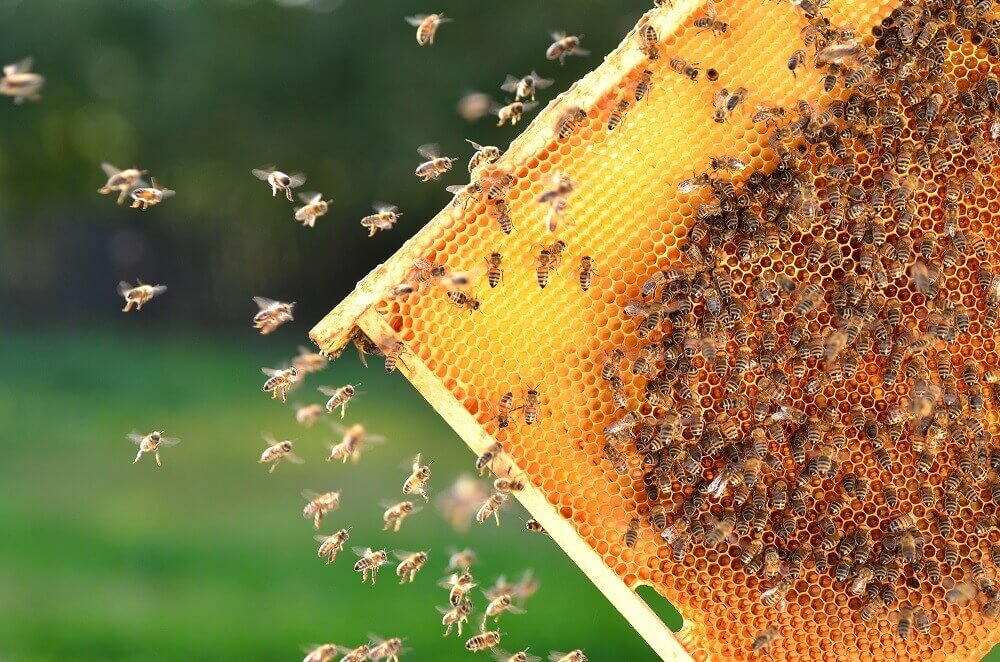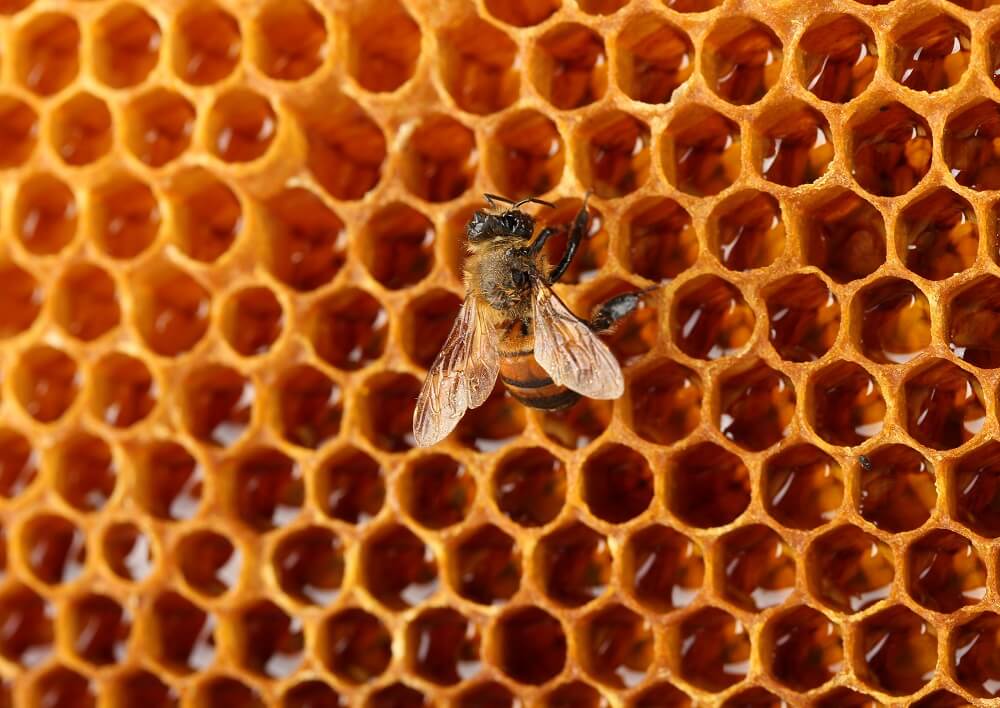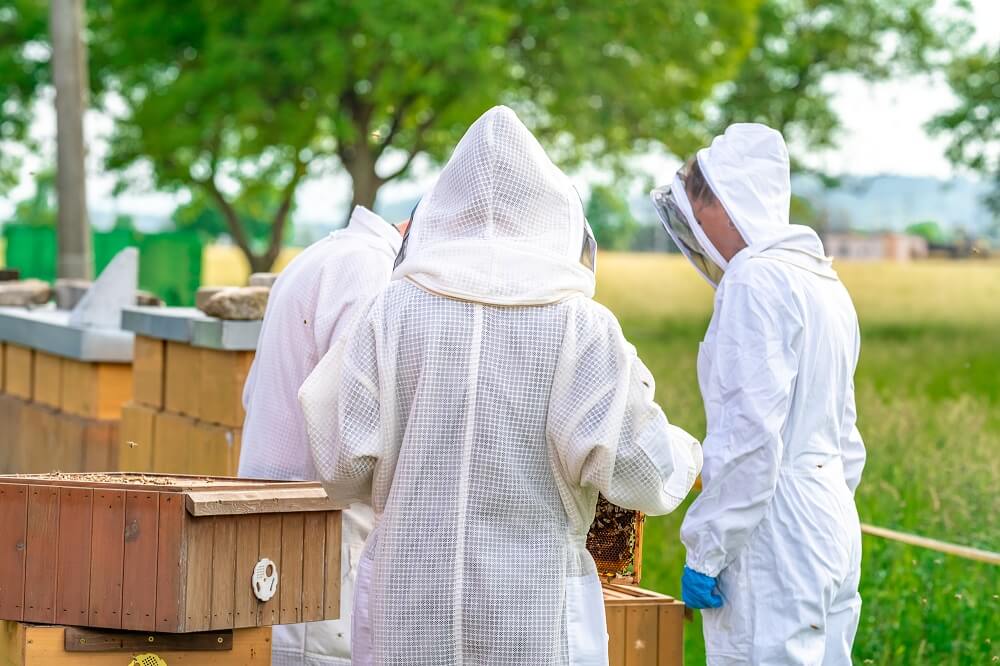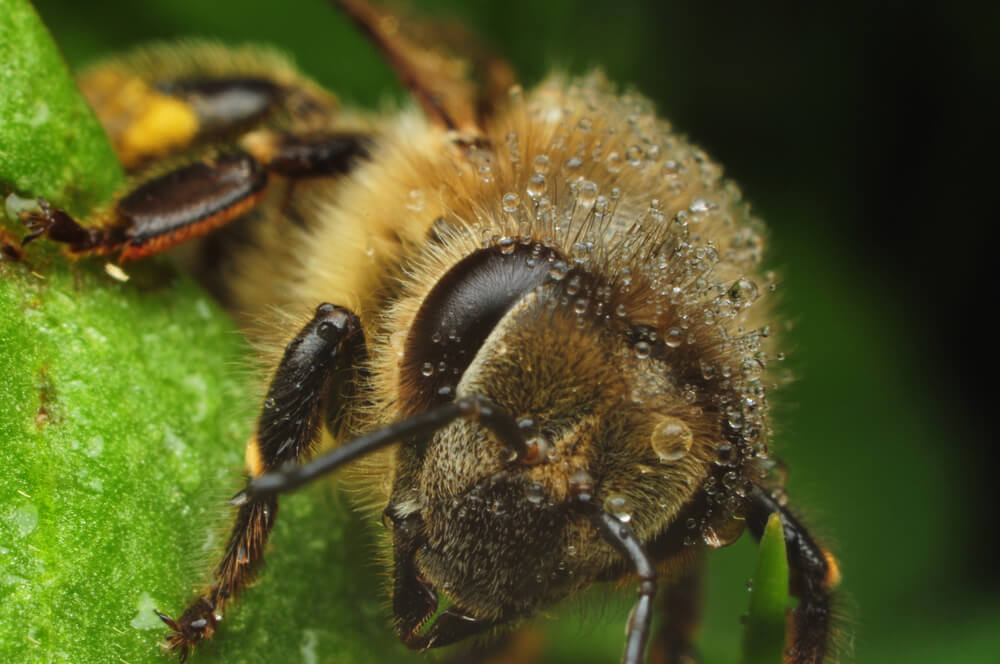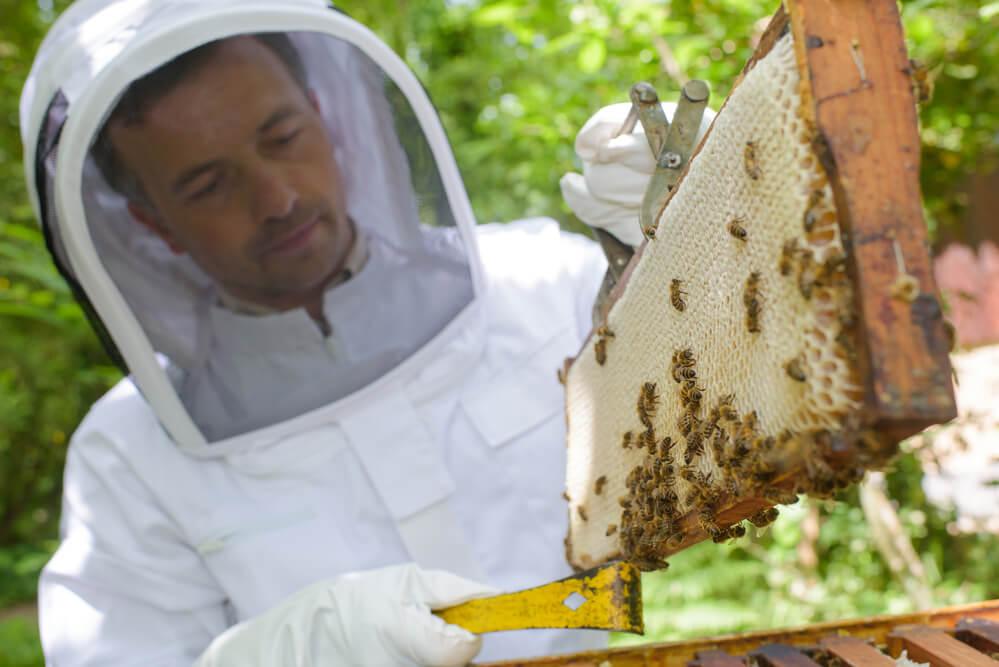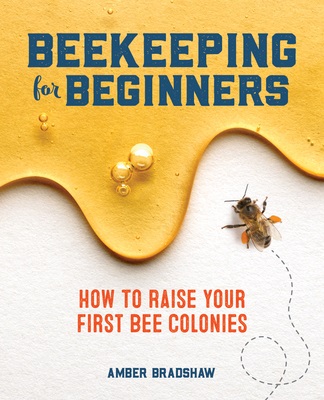In this article:
What is Backyard Beekeeping?
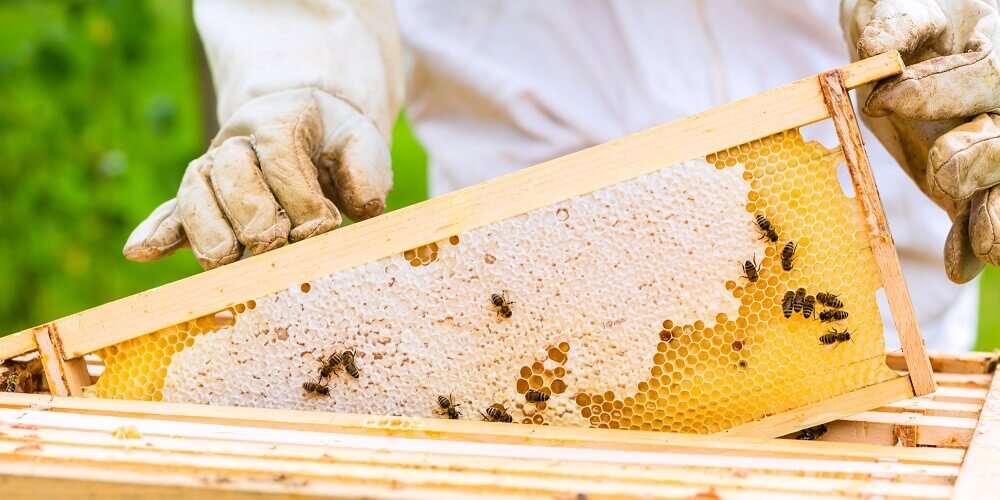
Backyard beekeeping refers to keeping bees in a suburban or city area. Backyard beekeepers usually have between one and five hives in their backyard.
So that begs the question:
Why is this a popular hobby?
Simple.
Backyard beekeeping is a lot of fun. Granted, it also takes patience and commitment, but it’s well worth it for the benefits you get.
Some benefits of beekeeping include:
- Promoting a healthy honeybee population
- Helping the environment through pollination
- Enjoying the liquid goodness called honey
But that’s only the beginning.
According to the USDA, bees are responsible for one in every three bites of food we take. This amounts to more than $15 billion in the nation’s crop value each year.(1)
Have I got your attention?
Good.
Now you might be asking…
How Do I Start Backyard Beekeeping?
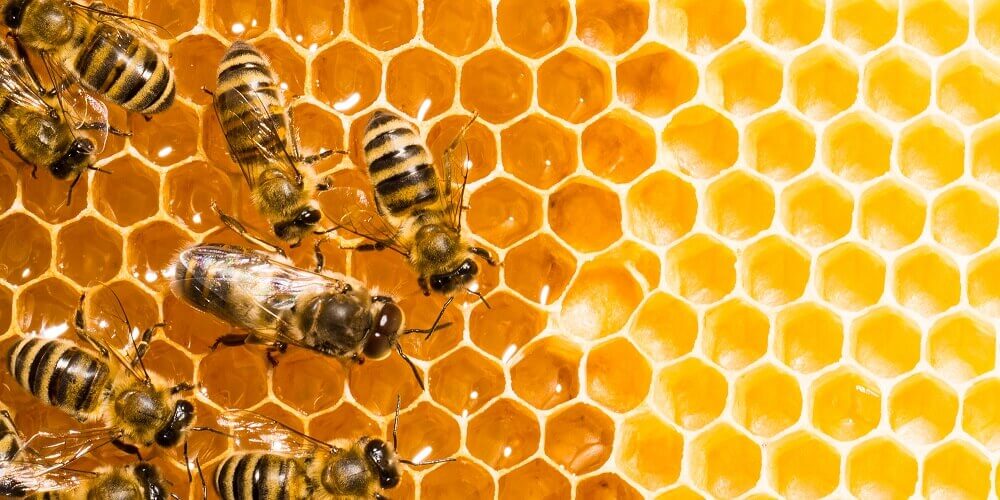
Picture this.
You were excited to become a backyard beekeeper and decided to jump in headfirst.
You bought your bees, got your hive ready, and had all the right beekeeping equipment. You had everything you needed to become a successful beekeeper.
Or so you thought.
One day, you notice several dead bees outside of the hive entrance. Upon further inspection, you realize your entire beehive is dead.
You feel surprised, disappointed, and maybe even a little guilty.
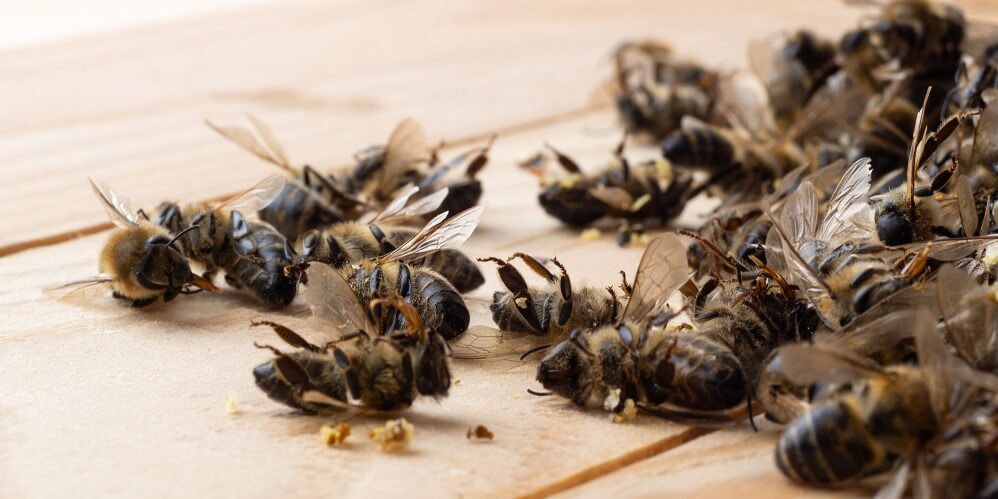
This happens more often than you might think.
How come?
Because beginner beekeepers get excited about the hobby without realizing what they’re walking into. Maybe they watch a few YouTube videos or read a few articles and think they’re ready to go.
That’s not the way it works.
But listen:
I don’t tell you this to scare you.
I tell you this to emphasize that the best way to start backyard beekeeping is through research. Read books, take courses, and watch as many videos as you possibly can.
Do this before jumping into beekeeping.
This is the book that I recommend. It’s the book that I read as a beginner, and it’s the book that I recommend to friends and family who want to become beekeepers.
But why is this so important?
Because it’s a big deal when a beehive dies, and it can actually hurt other bees in your area.
For example, if your hive becomes diseased, it can spread to other colonies and take down entire apiaries.
An apiary is a place where honeybees are kept and managed by beekeepers. Apiaries come in many sizes and can be suburban, urban, or rural.

So to recap, the best place to start as a backyard beekeeper is to dive into educational resources like this one. You’ll not only learn more about the fascinating life of bees, but it’ll also help you avoid common beekeeping mistakes that beginners make.
Now that we’ve covered that, let’s dive into the next topic…
The 3 Things to Consider Before Backyard Beekeeping
1. Your City Laws

Get this:
Some cities may dictate whether or not you can keep bees, control how many hives you have, and specify how far away your bees need to be placed from property lines.
I know, I know.
Local laws like this can make things tricky. So that’s why before you even buy bees or equipment, you should check with your local beekeeping association first.
2. Your Neighbors
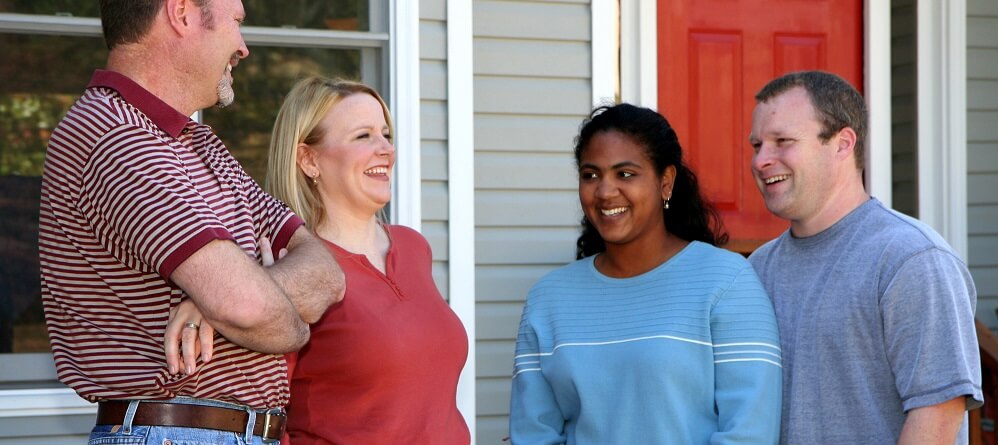
Here’s a rule of thumb for you:
Building a good relationship with your neighbors will make your life as a backyard beekeeper easier.
If you’re on good terms with your neighbors, then they’ll likely be excited about your new hobby. But, if you’re on bad terms with your neighbors, then becoming a beekeeper can add fuel to the fire.
So what’s the bottom line?
You should start by creating an open line of communication.
Give your neighbors your phone number and let them know they can call or text you anytime if they have questions.
For example, let’s say they notice a swarm in their backyard. Instead of panicking or trying to kill the bees, they can call you and let you handle it.
Also, keep in mind that some people are allergic to bee stings. This may not be the case for your neighbors, but it’s smart to know beforehand.
And last but not least?
It’s always smart to save a couple of jars of honey to give to your neighbors. It’s a nice way for a beekeeper to say “thank you.”
More importantly?
It’ll help them realize that having a beekeeper as a neighbor is a sweet deal.
3. The Location of Your Beehive

As realtors say:
Location, location, location.
As it turns out, placing your hive in a good location is one of the best things you can do for your bees.
So now the question becomes:
Where should I put my beehive in my backyard?
Here are a few tips:
Tip 1: Choose the Ideal Amount of Sun
Your bees need to be placed in a spot that gets morning sun. This warms up the hive and gets them up and going during the morning.
And don’t forget:
Your climate plays a huge factor too.
For example, if you live in a colder climate, you should put your hive in a place that receives full sun during the day. This will help your bees stay warmer during the colder months.
If you live in a hot climate, you should put your hive in a spot that gets morning sun and afternoon shade. This will keep your bees cooler during the hot summer months.
Tip 2: Avoid Direct Wind
You should put your hive in a place where there’s a windbreak. Trees, bushes, shrubbery, or fences will do the trick. This is especially crucial in cooler climates where the temperatures can drop below freezing.
Tip 3: Consider Food and Water Sources.
For starters, your bees must have access to safe water sources.
Keep in mind:
Bees can’t swim. This means they’ll need places to land so they can drink safely. For example, a shallow birdbath filled with water and marbles is a good option. The marbles serve as landing perches for the bees.
Check out our article on safe bee waterers if you need more options.
Another thing to keep in mind is food sources. It’s a good idea to plant the best flowers for bees, so your hive can thrive.
But, I understand that that’s not always an option.
Depending on your location, climate, and rainfall, you may need to make sugar water for bees. This is especially important when there is a nectar dearth. It can mean the difference between life and death for your colony.
Tip 4: Be Mindful of Predators
Let’s face it.
Honey is like liquid gold to many animals and insects.
No matter where you live, you’ll have some predators to contend with. This is where getting to know local beekeepers helps. Experienced beekeepers will offer useful tips and tricks for protecting your bees from predators.
The 10 Tools Every Backyard Beekeeper Needs
1. A Hive
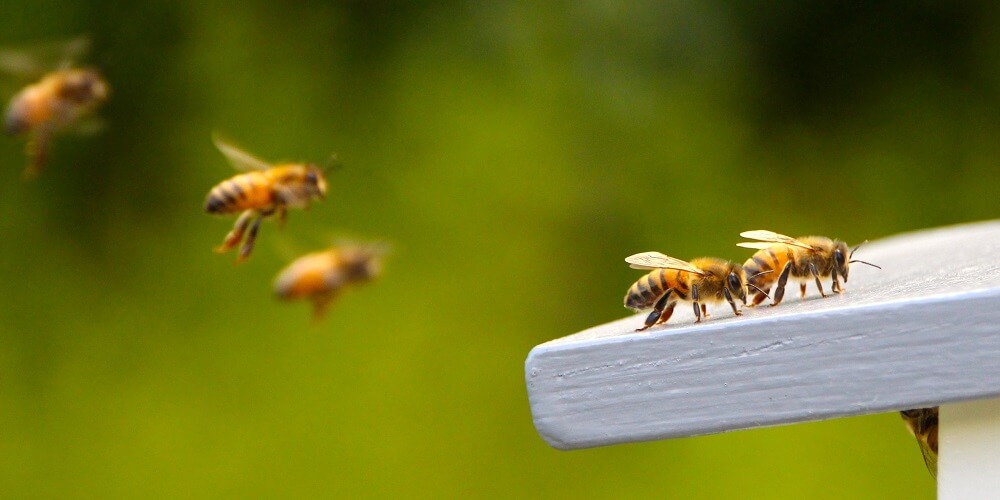
Surprise surprise:
Your bees need a place to live.
So let’s talk about the most common beehives.
Langstroth hives are the most common hives used by backyard beekeepers. They include stackable boxes with removable frames for the bees to build honeycomb in.
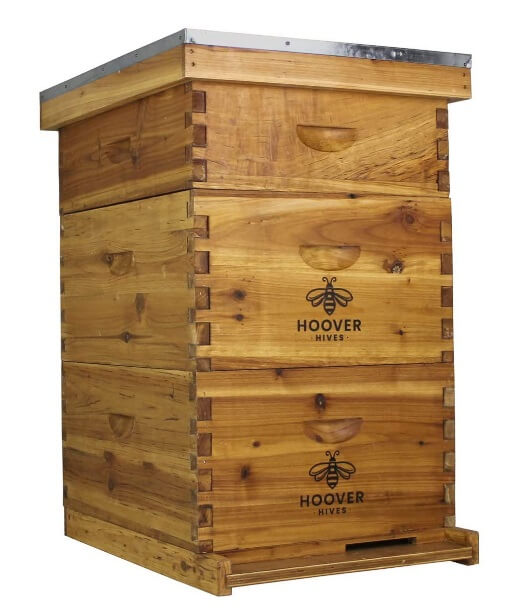
The box comes in 3 depths: shallow, medium, and deep. There are also two widths: 8 frames or 10 frames.
The biggest pro of the langstroth hives is that they’re popular which means there are a lot of accessories to go with them. It’s also a relatively inexpensive hives style, so it’s ideal for backyard beekeepers.
The biggest con of the langstroth hives is that they’re heavy. Boxes range from 30 to 70 pounds, so you might consider another option if you’re limited in physical strength.
The top bar hive has become a popular alternative to the langstroth hives. They are single-story, horizontal hives. This means you don’t have to stack heavy rectangular boxes onto one another.
Top bar hives also allow you to take a more natural approach to backyard beekeeping.
Why?
Because with the top bar hive, there are no frames. There are pieces of wood that hang on the top of the box and the bees build their honeycomb off of those.
The flow hive is another hive that has exploded in popularity over the last few years. It’s a langstroth-style hive with a built-in honey extractor.
It allows honey to pour straight out from a tap.
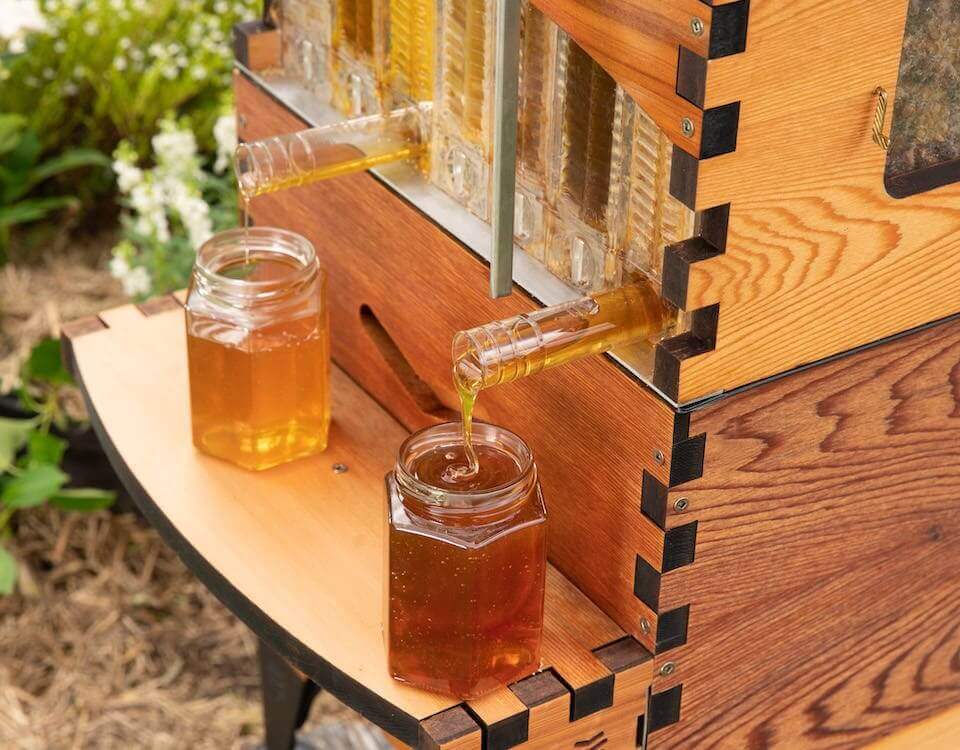
The biggest pro to the flow hive is that it makes honey extraction easy. The process is quick, and it doesn’t create a big mess.
More importantly?
It’s less invasive to bees because you don’t have to open the hive to extract the honey.
The biggest con to the flow hive is the cost. It’s more expensive than other types of hives. Also, you’ll still have to lift heavy boxes like you would with a traditional langstroth hive.
(Check out our flow hive review for more info).
And finally?
The warre hive is a vertical box system similar to the langstroth hive. The difference is that it features removable top bars instead of frames and uses square boxes instead of rectangular boxes.
The founder of the warre hive wanted to create a design that resembled how wild honeybees lived.
It allows the bees to build their own comb and has an observation window that you can use to check on your bees. This allows for less disturbance of your colony.
2. A Bee Suit
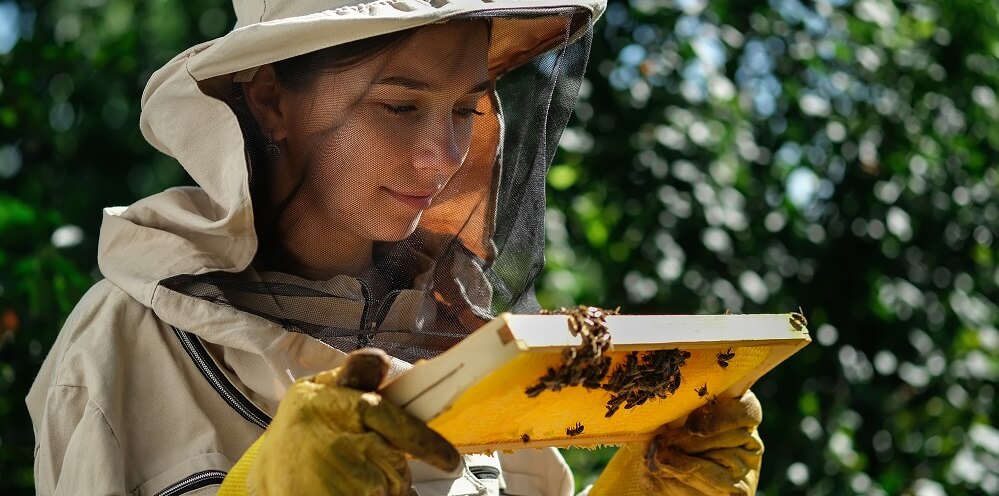
Want to know one of the biggest complaints I hear from backyard beekeepers?
It’s that they’re sweating bullets inside of their bee suit.
This is because many bee suits are made out of cotton material that isn’t ventilated. As a result, you feel miserable inside of your suit.
The solution?
Don’t cheap out on a bee suit. Instead, buy a high-quality bee suit that’s ventilated, so it allows the breeze to flow in. Trust me. You’ll thank me later.
3. Bee Smoker
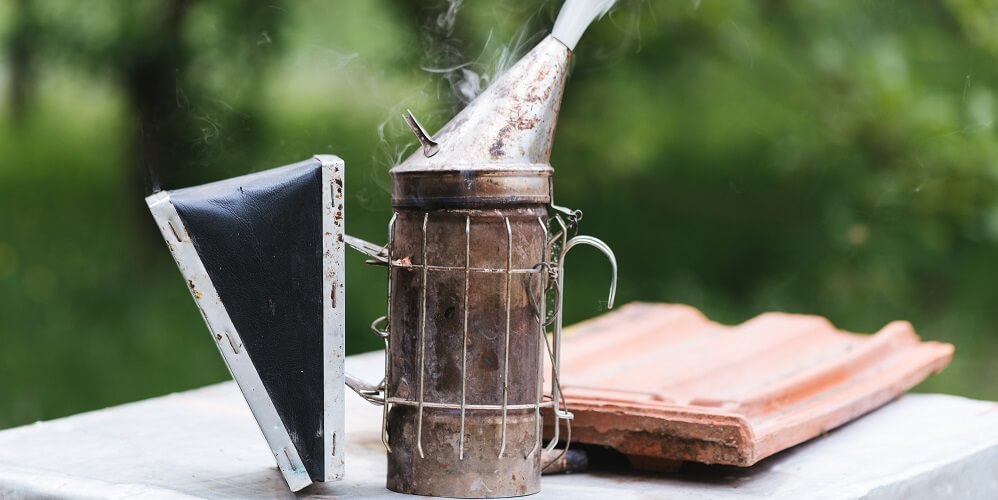
Bee smokers are essential tools for distracting your bees during inspections. They help protect you from bee stings, which saves your bees from unnecessary deaths.
4. A Hive Tool
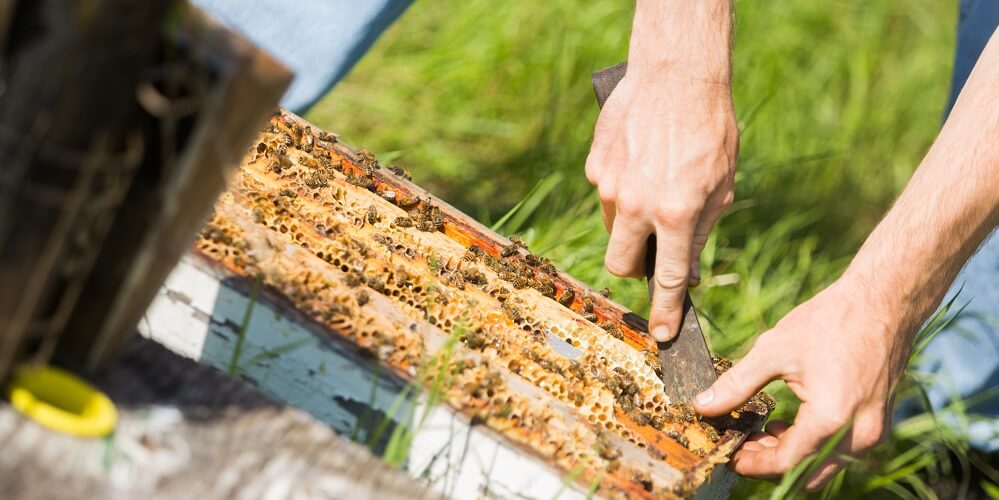
Bees line their hives with propolis. Propolis acts as a glue and insulation that holds everything together.
To break the seal, you’ll need a hive tool. They’re an inexpensive way to make pulling the frames apart easier.
5. A Queen Catcher
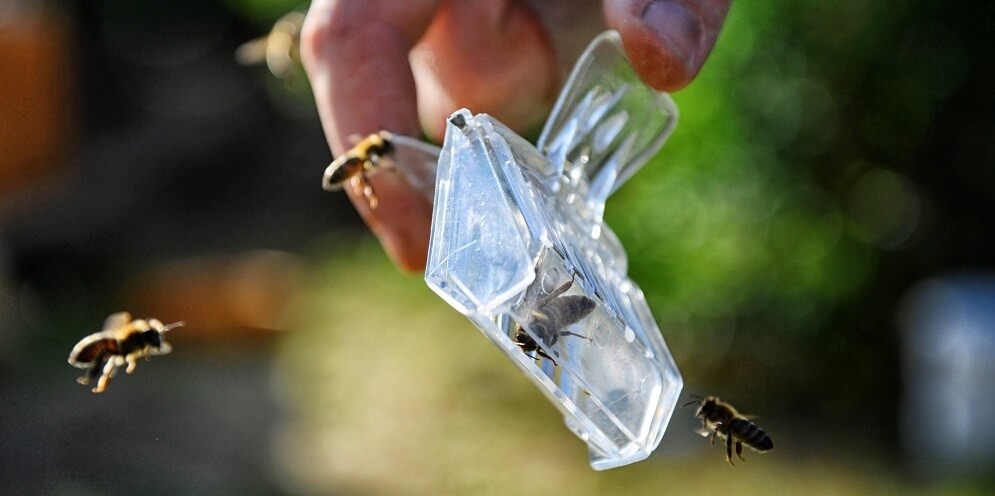
A queen catcher is a handy tool that allows you to temporarily separate the queen from her colony.
For example, you may need to catch the queen to mark her, which makes it easier to find her during hive inspections.
6. Gloves
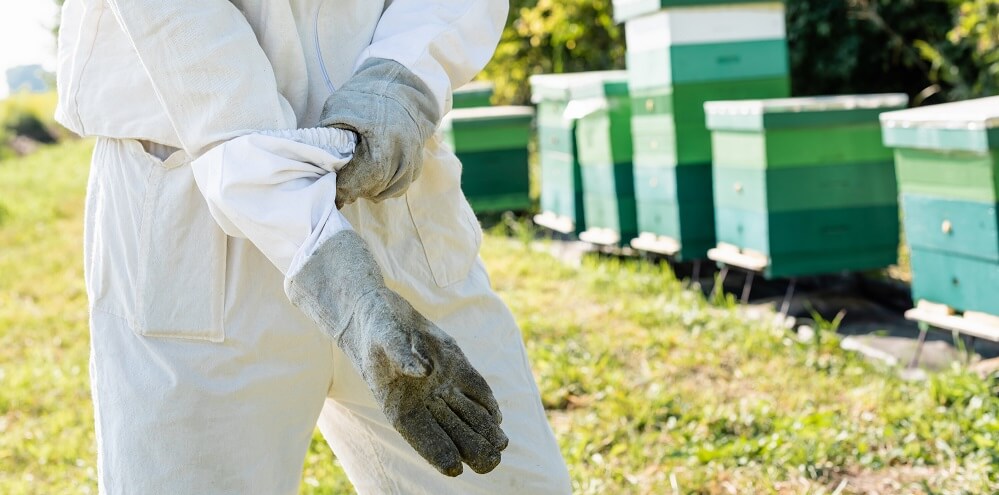
Alongside your bee suit, gloves will come in handy. You’ll lose some dexterity with beekeeping gloves, but at least your hands will be safe.
This allows you to work more methodically and intentionally without worrying about being stung.
7. Bee Waterers and Feeders

For starters, bees need a safe place to drink.
So your bee waterers will need to include landing perches like marbles.
Remember:
Bees can’t swim. Your bees will drown if they fall into the water and don’t have a safe place to climb on.
Secondly, your bees will sometimes need access to extra food when resources are low. Learning how to make sugar water for bees will help.
8. A Queen Marker
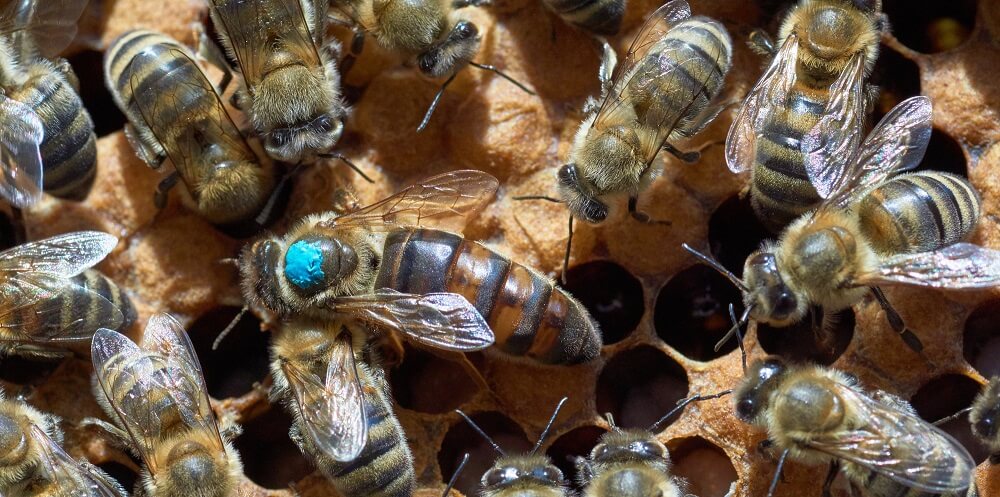
As a beginner backyard beekeeper, you’ll make your life easier if you keep your queen marked.
As you can imagine, your queen can easily get concealed in a sea of thousands of bees. Using a queen marker will be a lifesaver.
9. A Bee Brush

Your bee brush will allow you to gently remove bees from the frames, supers, or your bee suit. It’s a brush with long, soft bristles that won’t injure your bees.
That said, be sure to use a gentle hand when brushing bees away.
10. Honeybees
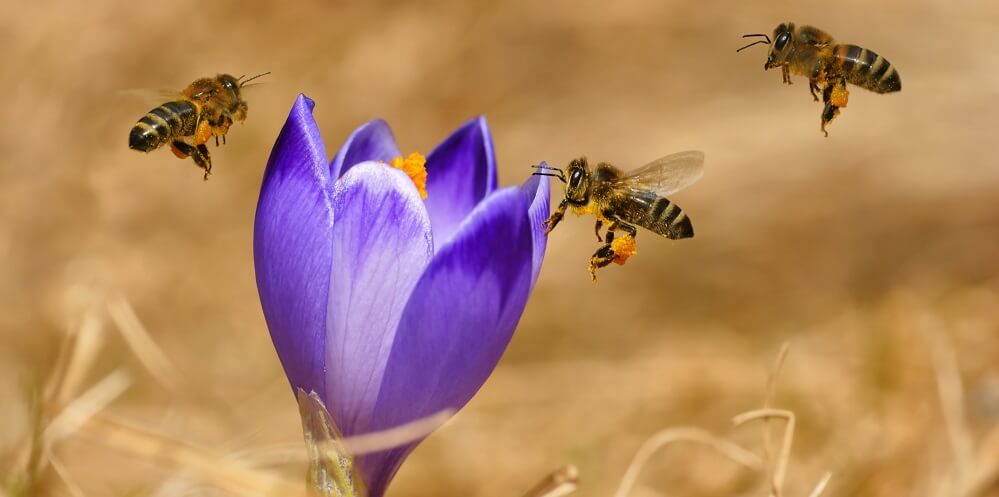
Last but not least, you can’t be a backyard beekeeper without bees.
The two common ways to buy bees are package bees or a nucleus hive.
Most packages will contain a queen, multiple workers, and a feeder with sugar syrup. It should also include instructions on installing your package of bees into their new hive.
A nucleus hive is called a “nuc” for short. It’s a half-size colony that includes a queen, bees, and brood (baby bees). Buying a nuc gives you a jumpstart in colony growth.
FAQs About Backyard Beekeeping
- Can you do beekeeping in your backyard?
- How much land do you need to keep bees?
- How much does a queen bee cost?
- How hard is it to raise bees?
- Can you keep a beehive in a small garden?
- Do you need permission to keep bees?
- Do beehives bother neighbors?
- Can you mow around beehives?
- Are there any backyard beekeeping kits?
- What’s the best backyard beekeeping book?
- Can I learn how to start a beehive without buying bees?
- How profitable is backyard beekeeping?
- Is it possible to learn how to start beekeeping for free?
Can you do beekeeping in your backyard?
Yes, small backyard beekeeping is very popular.
But keep in mind:
You’ll want to check with your city laws and make sure your neighbors are okay with it first.
Also, read a beekeeping book like this one to get yourself acquainted with your new hobby. It ensures that you know what you’re doing and can help you avoid rookie mistakes.
—> Go back to the backyard beekeeping FAQs
How much land do you need to keep bees?
The general rule of thumb is to have at least 5 feet of space in every direction around your hive. If you have multiple beehives, they should be spaced at least 3 feet apart.
Also, you want to check with your local laws. For example, some cities require at least 15 feet of space between a beehive and property lines.
Check out this list of local beekeeping organizations by state for more information.
—> Go back to the backyard beekeeping FAQs
How much does a queen bee cost?
On average, a queen bee costs between $30-$50. This is the price for a good quality, well-bred, healthy queen bee. If you order online, shipping costs will also be added to that amount.
—> Go back to the backyard beekeeping FAQs
How hard is it to raise bees?
The truth is that backyard beekeeping can be hard work, but it’s also very rewarding.
You get to enjoy a fascinating hobby and collect the delicious goodness called honey. That said, two of the hardest things about beekeeping are the physical aspect and keeping your bees alive and healthy.
That’s why I recommend educating yourself about backyard beekeeping first. You’ll not only learn ways to reduce the physical load, but you’ll also learn tips on how to keep your beehive alive and well.
The more you learn, the easier backyard beekeeping becomes because you’re not taking shots in the dark.
As a starting point, I recommend reading this book. It’ll get you acquainted with the ins and outs of backyard beekeeping for beginners.
—> Go back to the backyard beekeeping FAQs
Can you keep a beehive in a small garden?
Absolutely! Bees are kept anywhere from country orchards to urban cities.
Bees are assets to gardens because they’ll help pollinate your plants.
Remember:
The general rule of thumb is to give your beehive at least 5 feet of space in every direction.
You don’t want to put the hive in the middle of tall shrubs or trees. Bees need access to the morning sun, so avoid having too many shrubs or trees that shade your beehive during the morning.
Related: How Many Bees are in a Hive?
—> Go back to the backyard beekeeping FAQs
Do you need permission to keep bees?
It depends on where you live. Check with your local beekeeping organization for more information.
—> Go back to the backyard beekeeping FAQs
Do beehives bother neighbors?
This answer might surprise you.
Honeybees are usually gentle creatures. And the truth is, they typically won’t bother your neighbors when they’re out foraging for food.
How come?
Because when they’re away from their hive, they’re not in defense mode. They simply have nothing to protect. They’re just doing their job and collecting food for their colony.
So as long as you have enough space between your property line and your beehive, then you’re usually good to go.
And another thing:
Bees will fly up to 5 miles away from their hive to find food. This means there’s a good chance that they’ll fly right past your neighbor’s yard in search of a good food source.
In my experience, most people report no difference in the number of bees in their yard after their neighbor becomes a backyard beekeeper.
—> Go back to the backyard beekeeping FAQs
Can you mow around beehives?
In most cases, yes. But there are a few things you should know first.
For starters, I recommend wearing a bee suit or at least a veil when you’re mowing around your hive. Taking a sting to the face is no fun.
Secondly, be careful not to blow any grass toward your hive and don’t stand directly in front of the hive entrance. Standing in front of the entrance will block the bee’s flight path and can make them agitated.
If you follow those tips, then you’ll probably be fine.
—> Go back to the backyard beekeeping FAQs
More to Explore:
Are there any backyard beekeeping kits?
Yes, beekeeping kits are quite popular online. Here is a link to a good selection on Amazon.
—> Go back to the backyard beekeeping FAQs
More to Explore:
What’s the best backyard beekeeping book?
This is the one I recommend because it helped me immensely when I was a beginner. The author breaks things down in an easy-to-understand way and gets you excited about your new hobby.
—> Go back to the backyard beekeeping FAQs
More to Explore:
Can I learn how to start a beehive without buying bees?
Yes, this is called catching a swarm.
A swarm happens when a colony of bees becomes so large that it needs to divide in half. Half of the bees will leave their hive along with their queen with the intent of setting up a new home.
Swarming happens in the spring or early summer.
Now that begs the question:
Is it smart for a beginner backyard beekeeper to try to catch a swarm?
It depends.
You don’t want to try to catch a swarm blindly. You need to do your research and educate yourself as much as possible before attempting this.
Why?
Because there are a lot of risks involved. For example, if you live in an area with Africanized honeybees, you risk catching an aggressive hive.
Also, you never really know the health of the swarm. Swarms can be healthy, but they can also come with a load of pests like varroa mites. They can also have a frail queen or be queenless.
This is why I say the more you know about beekeeping, the better.
Do your research about backyard beekeeping before deciding to catch a swarm.
—> Go back to the backyard beekeeping FAQs
More to Explore:
How profitable is backyard beekeeping?
It depends on many things.
How many hives do you have?
How many revenue streams do you have from each hive?
Do you only sell honey? What about bees, propolis, beeswax etc. – do you sell those too?
My advice is to start by getting a hive or two and see how you like it first. From there, you can read guides like these to inspire your journey to become a full-time beekeeper.
—> Go back to the backyard beekeeping FAQs
More to Explore:
Is it possible to learn how to start beekeeping for free?
Unfortunately not. As with anything in life, it’ll either cost you your time or your money.
You’ll need to do your research and educate yourself on backyard beekeeping first. Then you’ll need to buy the beekeeping equipment necessary to start your own hive.
The cost to start as a backyard beekeeper is usually somewhere between $500-$750.
